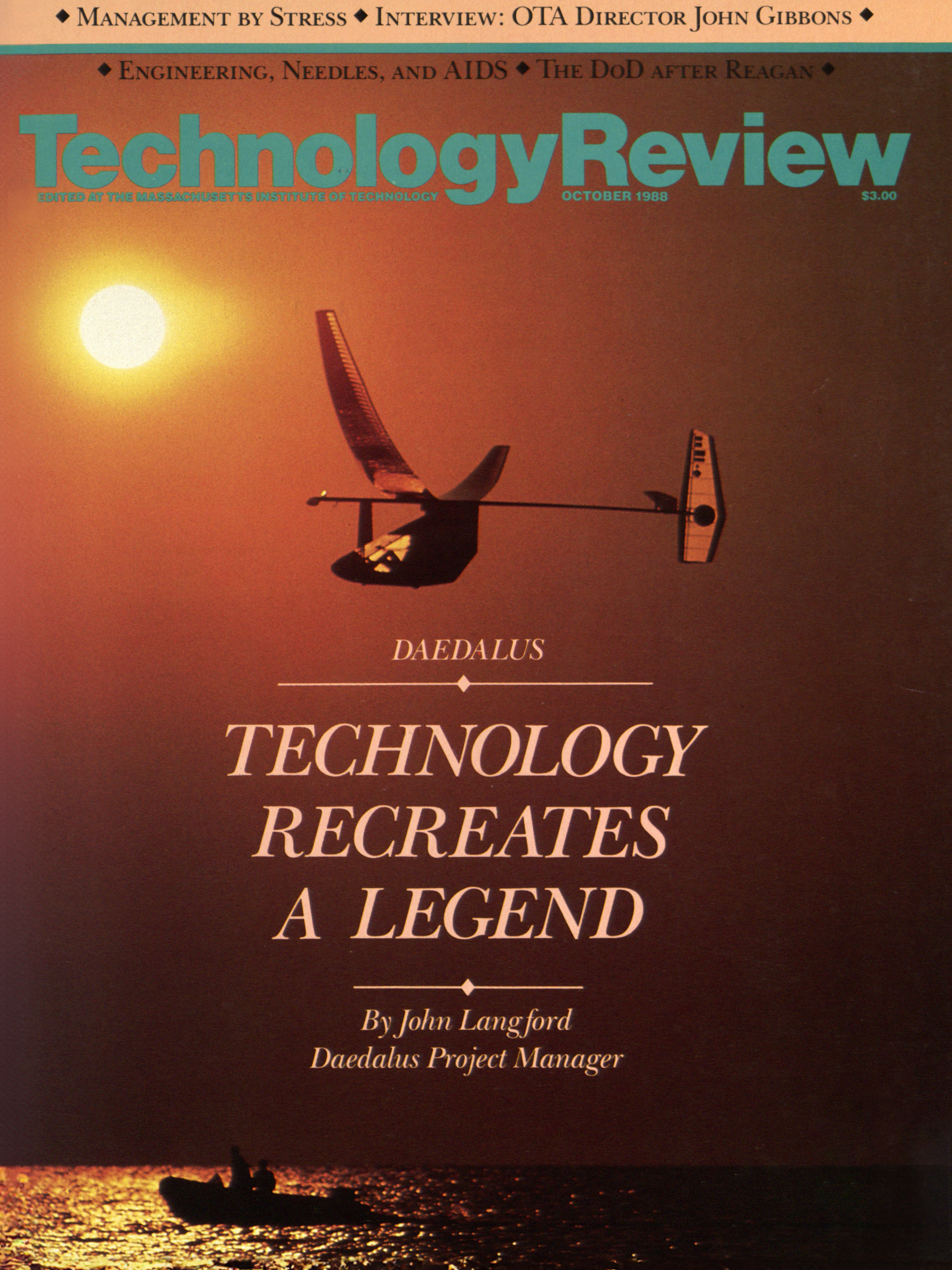What tech learned from Daedalus
Even 35 centuries ago, people imagined using technology to overcome physical limits.

Today’s climate-change kraken may have been unleashed by human activity—which has discharged greenhouse-gas emissions into Earth’s atmosphere for centuries—but reversing course and taming nature’s growing fury seems beyond human means, a quest only mythical heroes could fulfill. Yet the dream of human-powered flight—of rising over the Mediterranean fueled merely by the strength of mortal limbs—was also the stuff of myths for thousands of years. Until 1988.
That year, in October, MIT Technology Review published the aeronautical engineer John Langford’s account of his mission to retrace the legendary flight of Daedalus, described in an ancient Greek myth recorded by the Roman poet Ovid in Metamorphoses. Imprisoned on the island of Crete with his son Icarus, Daedalus, a skilled inventor, crafts wings of feathers and wax to escape. In his exuberance, Icarus defies Daedalus’s warning not to fly too close to the sun. His wings melt and he plummets to his death. With heavy heart, Daedalus completes the flight, landing in Sicily.
“Daedalus became a quest to build a perfect airplane,” says Langford, reflecting on his project team’s mission. By some measures, they succeeded. Their plane, Daedalus 88, still holds the record for absolute distance (71.5 miles, or 115 kilometers) and duration (nearly four hours) of a human-powered flight.
Of course, Langford’s team modified some of the mythical parameters. The aircraft replaced feathers and wax with carbon-fiber wings, and the pilot, the Greek cyclist Kanellos Kanellopoulos, didn’t flap his way into history—he pedaled. Plus, the 500-mile journey to Sicily seemed beyond mortal capacity, so Langford and his team set their sights on Santorini.
The problem with the Daedalus project, and human-powered aircraft of any kind, is the grueling effort to remain aloft, the risk of crashing, and the expense—none of which was lost on Langford. “In itself, our Daedalus project could never answer the question ‘So what?’” he admits.
At the time, unseen clouds of human-generated chlorofluorocarbons, gathering in Earth’s stratosphere for half a century, had blasted a seasonal hole in the protective ozone layer over Antarctica, signifying a disaster unfolding across Earth’s atmosphere. As the global community rallied, the “So what?” he was looking for emerged.
To Langford, an entrepreneur whose twin passions are climate research and sustainable aeronautics, the perfect plane is an unmanned aerial vehicle able to ply the stratosphere, collect climate data such as ozone readings, and harness the sun for its energy needs. Aurora Flight Sciences, his first company, unveiled such a plane, Odysseus, in 2018. His latest company, Electra, wants to decarbonize all aviation.
That a human-powered plane able to fly mere meters above the sea for a handful of hours managed to inspire solar-powered robotic planes that continuously comb Earth’s stratosphere could make sense only in the context of our climate challenges. Such novel aircraft symbolize the ability of human beings to achieve mythic feats when joined in a common quest, however daunting.
Bill Gourgey is a science writer based in Washington, DC, and teaches science writing at Johns Hopkins University.
Keep Reading
Most Popular
How scientists traced a mysterious covid case back to six toilets
When wastewater surveillance turns into a hunt for a single infected individual, the ethics get tricky.
The problem with plug-in hybrids? Their drivers.
Plug-in hybrids are often sold as a transition to EVs, but new data from Europe shows we’re still underestimating the emissions they produce.
An AI-driven “factory of drugs” claims to have hit a big milestone
Insilico is part of a wave of companies betting on AI as the "next amazing revolution" in biology
Stay connected
Get the latest updates from
MIT Technology Review
Discover special offers, top stories, upcoming events, and more.